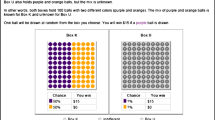Abstract
Assume a decision maker has a choice between several acts. Some of the alternatives are simple lotteries; others consist of gathering additional (costy) information on outcomes or probabilities of the available simple lotteries prior to making a binding choice between them. In this paper hypotheses are derived from the Choquet Expected Utility model about the relationship between the degree of ambiguity aversion and the willingness-to-pay for information revealing the outcome of simple two-state-lotteries. These hypotheses are tested experimentally. 157 students are asked to state their willingness-to-pay for information, revealing the true payment relevant state, before making choices between a certain amount of money and two-state-lotteries of varying degrees of ambiguity. In the experiment the pessimism predicted by the Choquet Expected Utility model is not observed empirically.
Zusammenfassung
Ein Entscheider hat die Wahl zwischen mehreren Handlungsalternativen. Einige Alternativen sind einfache Lotterien. Andere bestehen darin, zunächst zusätzliche Informationen über Ergebnisse oder Eintrittswahrscheinlichkeiten von Ergebnissen bei diesen Lotterien zu erwerben, bevor eine verbindliche Wahl zwischen den Lotterien getroffen wird. In diesem Artikel werden Hypothesen über den Zusammenhang zwischen demGrad der Ambiguitätsaversion und der Zahlungsbereitschaft für Informationen über das Ergebnis einfacher Zwei-Zustände-Lotterien aus demChoquet-Erwartungsnutzen-Modell abgeleitet. Diese Hypothesen werden in einem Experiment getestet. 157 Studenten werden, bevor sie sich zwischen einer sicheren Zahlung und Lotterien unterschiedlicher Ambiguität entscheiden müssen, nach ihrer Zahlungsbereitschaft für die Information, welcher von zwei zahlungsrelevanten Umweltzuständen eintritt, gefragt. Das wichtigste Ergebnis des Experiments ist, daßder vom Choquet-Erwartungsnutzen-Modell vorhergesagte Pessimismus bei der Bewertung von Information empirisch nicht beobachtet werden kann.
Similar content being viewed by others
References
Baron J, Frisch D (1988) Ambiguity and Rationality. J Behav Dec Making 1: 149–157
Bowen J, Qiu ZJ (1992) Satisficing when Buying Information. Organ Behav Human Dec Proc 51: 471–481
Camerer C, Weber M (1992) Recent Developments in Modeling Preferences: Uncertainty and Ambiguity. J Risk Uncertainty 5: 325–370
Eisenberger R, Weber M (1995) Buying and Selling Gaps for Ambiguous Lotteries. J Risk Uncertainty 10: 223–233
Ellsberg D (1961) Risk, Ambiguity, and the Savage Axioms. Q J Econ 75: 643–669
Farquhar PH (1984) Utility Assessment Methods. Manag Sci 30: 1283–1300
Gilboa I, Schmeidler D (1989) Maxmin Expected Utility with A Non-Unique Prior. J Math Econ 18: 141–153
Keppe H-J, Weber M (1995) Judged Knowledge and Ambiguity Aversion. Theory Dec 39: 51–77
LaValle IH (1968) On Cash Equivalents and Information Evaluation in Decisions under Uncertainty. J Am Stat Assoc 63: 252–296
LaValle IH, Xu Y (1990) Information Evaluation under Nonadditive Expected Utility. J Risk Uncertainty 3: 261–275
Mangelsdorff L, Weber M (1994) Testing Choquet Expected Utility. J Econ Behav Organ 25: 437–457
Savage LJ (1954) Foundations of Statistics. Dover, New York
Schlee E (1990) The Value of Information in Anticipated Utility Theory. J Risk Uncertainty 3: 83–92
Schmeidler D (1989) Subjective Probability and Expected Utility without Additivity. Econometrica 57: 571–587
Wakker P (1988) Nonexpected Utility as Aversion of Information. J Behav Dec Making 1: 169–175
Author information
Authors and Affiliations
Additional information
Funding for the work was provided by the Deutsche Forschungsgemeinschaft, grant No. We 993/5-3
Rights and permissions
About this article
Cite this article
Berg, M., Eisenberger, R. An experiment on the evaluation of information under risk and ambiguity. OR Spektrum 18, 179–186 (1996). https://doi.org/10.1007/BF01539711
Received:
Accepted:
Issue Date:
DOI: https://doi.org/10.1007/BF01539711




